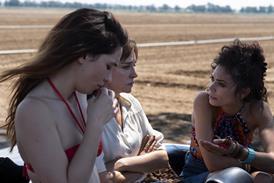
Five directors with four films in the Tiger competition of the International Film Festival Rotterdam (IFFR) discussed the intensely personal nature of their stories and the visual arts used to transfer them onto the screen during this edition’s first live online daily press conference on Saturday (January 29).
Filmmakers Lei Lei, Yamasaki Juichiro, David Easteal, Renaud Després-Larose and Ana Tapia Rousiouk revealed how they made sense of personal experiences before expressing them through various visual mediums including animation, sound and 16mm footage during the event hosted by IFFR festival director Vanja Kaludjercic.
Lei Lei’s dreamy animation Silver Bird And Rainbow Fish recounts the director’s family history set against the tumultuous backdrop of China in the 1950s and 1960s with all the hardships this era entailed. The filmmaker created his own vivacious animation, mixing materials and reinventing them to create a dramatic visual language involving clay puppets, bright colours and propaganda.
“I went back to my hometown and found so many stories that I didn’t know about my family, so then I started to interview them,” said the Chinese filmmaker. “That’s when I had the idea of using animation to rebuild my family story.” It also inspired the director to explore his own identity through his family’s past.
Japan’s Yamasaki Juichiro chose to shoot Yamabuki, a fraught drama set in his hometown of Minawa, on 16mm film. The decision “was not based on a very strong conviction, but an experimental choice. I had this assumption that the nature, the mountains and the protagonists in this film would work out best when using 16mm. Looking at the result, I think it worked out very successfully,” the filmmaker said.
Juichiro grew up in this once-rural backwater surrounded by a constant influx of foreign workers seeking employment at local mining concerns. The harsh and rigid environment combined with the grainy 16 mm footage to portray a community very much ill at ease. In addition, its muted colours and grainy texture provided an overall documentary effect to this Japan-France co-production.
Daily commute
Meanwhile, David Easteal’s feature length debut The Plains saw the Australian filmmaker shoot almost all of the entire three hours through a fixed camera perspective that provided a backseat view of a middle-aged Australian lawyer’s daily commute back from work.
“It was a very personal story, The man who is the protagonist in my film is someone who I worked with,” Easteal said during the press conference. “Our relationship, our friendship developed over the years. I learnt about his ailing mother, his wife. That’s why I made this film, it is what I knew.”
“A big part of the film is discussions and talking and the way we communicate in cars, and this film is very much based on this reality,” he continued. “We are both looking forward and talking, and it creates this very interesting space where people can talk more freely. Removing the camera from eyesight maintained this. I didn’t want the camera where you could see it.”
Canadian filmmakers Renaud Després-Larose and Ana Tapia Rousiouk borrow from experimental 20th century film movements to merge sound and visual effects to paint an alienating picture of contemporary society while fictionalising aspects of their own lives in Le Rêve Et La Radio.
The directors play the two leads in the film, which addresses their real-life fears and dreams through an aspiring writer and a woman who works for an independent radio station.
“A lot of the discussions when we were writing the script were about sound, and ways in which we could capture the city and how this would seep into our apartment from far away, so feeling the noise, the traffic from the periphery, as we don’t live in the centre of the city. It’s about feeling the oppression.”
IFFR runs January 26 to February 6. The winner of the Tiger competition will be announced at an awards ceremony on February 2..

























No comments yet